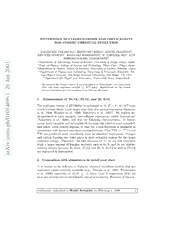
Hypernova Nucleosynthesis and Implications for Cosmic Chemical Evolution PDF
Preview Hypernova Nucleosynthesis and Implications for Cosmic Chemical Evolution
HYPERNOVA NUCLEOSYNTHESIS AND IMPLICATIONS FOR COSMIC CHEMICAL EVOLUTION TAKAYOSHINAKAMURA1, HIDEYUKIUMEDA1, KOICHIIWAMOTO2, KEN’ICHI NOMOTO1, MASA-AKIHASHIMOTO3, W. RAPHAELHIX4,AND FRIEDRICH-KARLTHIELEMANN5 1 1Department of Astronomy, School of Science, University of Tokyo, Tokyo, Japan 0 2Dept. of Physics, College of Science and Technology, Nihon Univ., Tokyo, Japan 0 3Department of Physics, School of Sciences, University of Kyushu, Fukuoka, Japan 2 4Department of Physics and Astronomy, University of Tennessee, Knoxville, TN n and Physics Division, Oak Ridge National Laboratory, Oak Ridge, TN, USA a 5Department fu¨r Physik und Astronomie, Universit¨at Basel, Switzerland J 6 Weexaminethecharacteristicsofnucleosynthesisin’hypernovae’,i.e.,supernovae 2 with very large explosion energies (>∼ 1052 ergs). Implications for the cosmic chemicalevolutionandtheabundances inM82arediscussed. 1 v 9 1 Enhancement of [Fe/O], [Ti/O], and [Si, S/O] 6 4 The explosion energy of SN1998bw is estimated to be E = 3 - 6×1052 ergs, 1 which is about thirty times largerthan that of a normal supernova (Iwamoto 0 et al. 1998; Woosley et al. 1999; Nakamura et al. 2001). We explore nu- 1 cleosynthesis in such energetic core-collapse supernovae, called ’hypernovae’ 0 / (Nakamura et al. 2000), and find the following characteristics. In hyper- h novae,bothcompleteandincompleteSi-burningtakeplaceinmoreextended, p and hence, lower density regions, so that the α-rich freezeout is enhanced in - o comparisonwithnormalsupernovanucleosynthesis. Thus44Ca(←44Ti)and tr 48Ti are produced more abundantly than in canonical supernovae. Oxygen s and carbon burning also takes place in more extended regions for the larger a : explosion energy. Therefore, the fuel elements O, C, Al are less abundant v while a larger amount of burning products such as Si, S, and Ar are synthe- i X sized by oxygenburning. In short, [Ti/O]and [Si, S, Ar/O]as well as [Fe/O] r are enhanced in hypernovae. a 2 Comparison with abundances in metal-poor stars Ti is known to be deficient in Galactic chemical evolution models that use supernova yields currently available (e.g., Timmes et al. 1995; Thielemann et al. 1996), especially at [Fe/H] <∼−1, when Type Ia supernovae (SNe Ia) havenotcontributedto the Galactic chemicalevolution. However,ifthe con- nakamura: submitted to World Scientific on February 1, 2008 1 tribution from hypernovae is relatively large, this problem could be relaxed, because, as we have seen, the α-rich freezeoutis enhanced in hypernovae and Ti is produced more abundantly than normal supernovae. Another feature of hypernova nucleosynthesis is a large amount of Fe. One hypernova can produce 2 - 10 times more Fe than normal core-collapse supernovae. This large iron production leads to small ratios of α-elements overironinhypernovae. Inthisconnection,theabundancepatternofthevery metal-poor binary CS22873-139 ([Fe/H] = −3.4) is interesting. This binary has only an upper limit to [Sr/Fe] < −1.5, and therefore was suggested to be a second generation star (Nordstr¨om et al. 2000; Spite et al. 2000). The interesting pattern is that this binary shows almost solar Mg/Fe and Ca/Fe ratios, as is the case with hypernovae. Another feature of CS22873-139 is enhanced Ti/Fe ([Ti/Fe] ∼ +0.6; Nordstro¨m et al. 2000; Spite et al. 2000), which could be explained by a hypernova explosion. 3 Abundances in the starburst galaxy M82 X-rayemissionsfromthestarburstgalaxyM82wereobservedwithASCAand the abundances ofseveralheavyelementsweremeasured(Tsuruetal. 1997). Tsuruetal. (1997)foundthattheoverallmetallicityofM82is quitelow,i.e., O/H and Fe/H are only 0.06 - 0.05 times solar, while Si/H and S/H are ∼ 0.40 - 0.47 times solar. This implies that the abundance ratios are peculiar, i.e., the ratio O/Fe is about solar, while the ratios of Si and S relative to O andFeareashighas∼6-8. Theseratiosareverydifferentfromthoseratios < 8 in Type II supernovae (SNe II). The age of M82 is estimated to be ∼ 10 years, which is too young for SNe Ia to contribute to enhance Fe relative to O. Tsuru et al. (1997) also estimated that the explosion energy required to produce the observed amount of hot plasma per oxygen mass is significantly larger than that of normal SNe II (here the oxygen mass dominates the total mass ofthe heavy elements). Tsuruet al. (1997)thus concluded that neither SN Ia nor SN II can reproduce the observed abundance pattern of M82. ComparedwithnormalSNe II,the importantcharacteristicofhypernova nucleosynthesis is the large Si/O, S/O, and Fe/O ratios. Figure 1 shows the goodagreementbetweenthehypernovamodelandtheobservedabundancesin M82(Umedaetal. 2001). HypernovaecouldalsoproducelargerE peroxygen massthannormalSNeII.Wethereforesuggestthathypernovaexplosionsmay make important contributions to the metal enrichment and energy input to the interstellar matter in M82. If the IMF of the star burst is relatively flat comparedwithSalpeter IMF, the contributionofverymassivestarsandthus hypernovae could be much larger than in our Galaxy. nakamura: submitted to World Scientific on February 1, 2008 2 Figure 1. Abundance patterns in the ejecta of 25M⊙ metal-free SN II and hypernova models compared with abundances (relative to the solar values) of M82 observed with ASCA(Tsuruetal. 1997). Here,theopencircleswitherrorbarsshowtheM82data. The filled square, triangle, and pentagons represent E51=1, 10, and 30 models, respectively, whereE51 istheexplosionenergy in1051 ergs. Theoretical abundances arenormalizedto theobservedSidata, andthemasscuts arechosen toeject0.07, 0.095,and0.12(M⊙)Fe forE51 =1,10,and30,respectively(Umedaetal. 2001). References 1. Iwamoto, K. et al. Nature 395, 672 (1998). 2. Nakamura, T., Mazzali, P. A., Nomoto, K., & Iwamoto, K. ApJ, 550, in press (2001), (asrto-ph/0007010). 3. Nakamura, T., Umeda, H., Iwamoto, K., Nomoto, K., Hashimoto, M., Hix, R., & Thielemann, F.-K. ApJ, submitted (2000), (astro- ph/0011184). 4. Nordstro¨m, B. et al., in The First Stars (MPA/ESO Astrophysics Sym- posia), eds. A. Weiss, T. Abel, & V. Hill (Berlin: Springer), 76, (2000). 5. Spite et al. A&A 360, 1077 (2000). 6. Thielemann, F.-K., Nomoto, K., & Hashimoto, M. ApJ 460,408 (1996). 7. Timmes, F. X., Woosley, S. E., Weaver, T. A. ApJS 98, 617 (1995). 8. Tsuru, T. G., Awaki, H., Koyama K., Ptak, A. PASJ 49, 619 (1997). 9. Umeda, H. et al., in preparation (2001). 10. Woosley, S. E., Eastman, R. G., & Schmidt, B. P. ApJ 516, 788 (1999). nakamura: submitted to World Scientific on February 1, 2008 3
